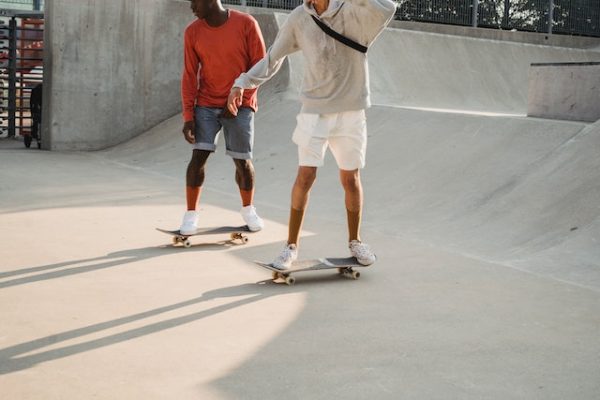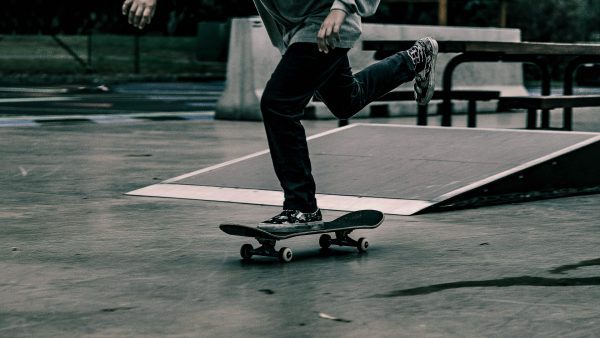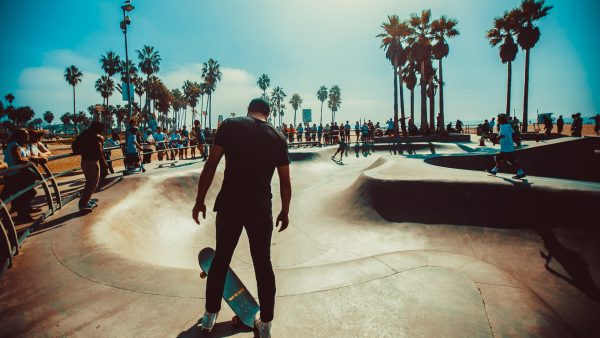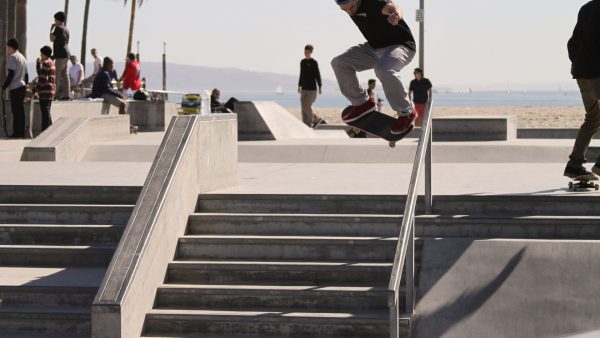Skating is a safety-focused sport that provides excitement for a skating beginner. Read essential tips on skateboarding safety, safety reminders and guides when you begin a skateboarding journey.

Whether you’re a kid or an adult, this beginner’s guide will equip you with valuable tips to ensure a safe and enjoyable experience while skateboarding. Let’s dive in and learn how to skate responsibly and practice safety! Read on to find about safety tips and keeping all parts of your body protected!
Skateboarding Takeaways
- Prioritize skate safety and wear proper protective gear while skateboarding.
- Understand and master the skate basics of skateboarding before attempting advanced skate tricks.
- Choose designated skate areas or skate parks for a safe and suitable environment.
- Learn how to fall safely by rolling with the fall and protecting your head.
- Enhance your skateboarding skill by avoiding attempting dangerous skate stunts beyond your skate skill level to prevent skateboard injuries.
- Regularly maintain your skateboard by checking for damage, cleaning, and lubricating skate components.
- Stay healthy and fit through regular exercise, stretching, proper nutrition, and hydration.
- Listen to your body, take breaks when needed, and seek medical attention for any discomfort or pain after skating.
- Keep your skin safe from the sun’s harmful rays during outdoor skate sessions.
- Embrace responsible skating habits and set a positive example for others in the community.
Understanding The Basics For Fun Skateboarding
You’ve probably seen others do it, but before you jump on that board and start cruising, it’s crucial to understand the very basics of skateboarding.

Understanding the basics of skateboarding, whether you’re at a skate park or on the streets, is crucial for safety, skill development, and enjoyment. Mastering fundamental techniques builds confidence, prevents injuries, and lays a strong foundation for learning more advanced tricks. With a grasp of the basics, you can adapt to different skate spots, communicate with other skaters, and experience long-term progress in your boarding journey. So, take the time to learn and practice the essentials, and you’ll embark on a fulfilling and safe skateboarding adventure.
Key Basics For A Safe Longboarding In The City
The basics for beginners in boarding include fundamental techniques that every skateboarder should learn before moving on to more advanced tricks. Here are the key basics for beginners in skateboarding:
- Stance: Determine whether you are regular-footed (left foot forward) or goofy-footed (right foot forward). Your stance dictates how you position your feet on the skateboard.
- Pushing: Use your back foot to push off the ground while keeping your front foot on the skateboard. This propels you forward and is the primary method of getting around on a skateboard.
- Balance: Develop a sense of balance while standing on the skateboard. Distribute your weight evenly between your front and back foot to maintain stability and find the optimal center of gravity for better control.
- Turning: Practice turning by shifting your weight and applying pressure to the toes or heels of your feet. This allows you to steer the skateboard in different directions.
- Stopping: Learn different methods of stopping, such as dragging your back foot on the ground (foot brake) or using your front foot to pivot the board sideways (power slide).
- Kickturn: Execute a kickturn by lifting the front wheels off the ground while turning the board in the direction you want to face.
- Ollie: The ollie is a fundamental trick that involves popping the tail of the skateboard down and sliding your front foot up to level out the board in mid-air.
- Riding Ramps: If you have access to a skate park with ramps, practice riding up and down small inclines to get comfortable with transitions and changes in elevation.
- Fakie and Nollie: Practice riding and turning in the opposite direction (fakie) and popping the nose of the skateboard (nollie) to gain better board control.
- Falling Safely: Learn how to fall correctly to minimize the risk of injuries. Practice rolling with the fall to distribute impact evenly and avoid landing on your hands or wrists, aiming to land on the fleshy parts of your body. When you land on the fleshy parts during a fall, it reduces injury risk since they provide better cushioning and absorb impact more effectively than bony areas, minimizing the severity of falls.
By mastering these basic skills and skateboarding safety, safety reminders and guides, you’ll build a strong foundation for your skateboarding journey and be better prepared to tackle more challenging tricks and maneuvers as you progress. When you ride a skateboard, always prioritize skateboarding safely and wearing protective gear while skateboarding to avoid serious injury.
Protective Gear For Safety Riding In The City Streets
Choosing The Right Protective Gear
Choosing the right protective gear is crucial for ensuring your safety while skateboarding. Here are the essential items you should consider:
- Skateboard Helmet: A certified skateboard helmet is the most critical piece of protective gear. Your helmet should fit snugly on your head, covering your forehead and the back of your head. Find a helmet that not only meets but doesn’t exceed safety standards and provides adequate impact protection. A multi-sport helmet can work for this sport, but ensure it meets the safety standards to ensure optimal skateboard safety.
- Elbow and Knee Pads: Elbow pads reduce the risk of joint injuries. Elbow pads and knee pads are essential for protecting your joints, including the fleshy parts, during falls. Look for pads that have a hard outer shell for impact resistance and a comfortable inner lining.
- Wrist Guards: Wrist guards provide support and protection for your wrists, which are often vulnerable during skateboarding falls. They can prevent sprains and wrist fractures.
- Skate Shoes: Heavy-duty gear, including proper skate shoes, is essential. Choose shoes with flat, grippy soles that provide a good board feel and ankle support.
- Protective Clothing: Consider wearing long-sleeved shirts and pants made of durable and breathable materials. They can offer some protection against scrapes and abrasions.
- Mouthguard (Optional): If you’re engaging in more aggressive skateboarding, such as vert skating or street skating with tricks, wearing a mouthguard can protect your teeth and mouth in case of a fall.
- Tailbone and Hip Pads (Optional): For those starting or looking for extra protection, tailbone and hip pads can help reduce the impact of falls on these sensitive areas.
- Consider the Fit: Ensure that all your protective gear fits properly and is comfortable to wear. It should stay securely in place during movement without being too tight or restrictive.
- Check for Quality: Invest in high-quality protective gear from reputable brands. While it may cost more upfront, the added safety and durability are worth it.
- Replace Damaged Gear: Regularly inspect your protective gear for any signs of wear and tear. If any item becomes damaged, replace it promptly to maintain optimal protection.
Remember that wearing the right protective gear significantly reduces the risk of serious injuries while skateboarding. A person on a skateboard should prioritize their skateboarding safety above all else. It allows you to enjoy the sport with confidence and peace of mind, knowing that you’ve taken steps to stay safe on your skateboard. This isn’t a simple small thing, it’s protecting all the parts of your body. These safety tips are crucial for a safe and enjoyable skateboarding experience.
Safe Skating
Safe skateboarding habits are essential for a positive and secure experience, minimizing the risk of skateboarding injuries. Always practice skateboarding safely around other skateboarders, stick to designated skate parks or areas, know your skill level, and practice falling safely to enhance overall skateboard safety, especially for younger skaters. Follow these tips to teach your kids how to stay safe!
Be mindful of your surroundings and respect traffic rules if skating on streets. There are no safe places, you can get injured anywhere, especially if you ride in the street. So always practice the skateboarding safety tips. Regularly check your equipment to ensure it is in working order, skate with a friend, and be prepared to seek emergency medical care if needed. By following these habits, you can enjoy skateboarding safely and responsibly, minimizing potential risks and skateboarding injuries.
Safest Skateboarding
Skateboarding in designated areas is essential for a safe and enjoyable experience. These specially created spaces, like skate parks, offer a controlled environment with proper obstacles and smooth surfaces, minimizing the risk of accidents and skateboard injuries and promoting safe skateboarding.
It also demonstrates respect for others and complies with local laws. Designated areas foster a sense of community, allowing skateboarders to connect, share knowledge, and progress their skills together. By exploring other designated skateboarding areas, skateboarders contribute to the growth of the skateboarding culture and inspire others to adopt responsible skateboarding practices on how to stay safe.

Skateboarding Injuries
Prioritizing safety is crucial in skateboarding, and one way to achieve this is by avoiding dangerous stunts. Steer clear of risky maneuvers that exceed your skill level to prevent injuries and long-term health issues. Instead, concentrate on mastering the basics and gradually advancing your skills. By setting a positive example, respecting your limits, and resisting peer pressure, you can enjoy longboarding responsibly while fostering a safe and enjoyable experience for yourself and others. Remember, the key to a fulfilling skateboarding journey is skill progression and awareness of how to stay safe

Beginner’s Safe Skateboarding
Learning how to fall safely is crucial for skateboarders. Adhering to essential safety rules like rolling with the fall, protecting your head, and using your hands wisely can reduce the risk of facial injuries. Aim to fall on fleshy areas and stay relaxed to absorb impact better. Being aware of your surroundings and falling away from your board can also help prevent additional injuries. Additionally, always ensure your skateboard is in working order to minimize the chances of accidents.
Practice falling on soft surfaces to build confidence and muscle memory. The parts of your body are very important, so do everything in your power to always practice skateboarding safety. Remember, prevention through proper protective gear within your skill level is the best way to avoid falls and accidents altogether. Having first aid safety kits in your home and in your bag is also a good idea!
Maintaining Beginner Skateboard For Safety
Maintaining your skateboard is essential for optimal performance and safety. Regular upkeep can extend the life of your board and prevent potential accidents caused by worn-out or damaged components. Here are some crucial tips for maintaining your skateboard:
- Check for Damage: Routinely inspect your skateboard for any signs of damage, including serious defects such as cracks, chips, or warping. Pay close attention to the deck, trucks, wheels, and bearings.
- Clean Your Board: Keep your skateboard clean by wiping it down with a damp cloth regularly. This removes dirt, debris, and grime, which can affect the board’s performance, especially on irregular surfaces, and lead to premature wear.
- Tighten Loose Hardware: Check the bolts and nuts on your trucks regularly. If they’re loose, tighten them appropriately to ensure stability and prevent wheel wobbling.
- Replace Worn-out Griptape: If your griptape is excessively worn or has lost its grip, consider replacing it. A good grip ensures your feet stay firmly on the board, improving control and safety.
- Rotate Your Wheels: Rotate your skateboard wheels regularly to promote even wear. This helps extend the lifespan of the wheels and maintains a smoother ride.
- Replace Damaged Wheels: If your wheels are cracked, flat-spotted, or have worn-down edges, it’s time to replace them. Quality wheels are essential for a smooth and controlled ride.
- Clean and Lubricate Bearings: Cleaning and lubricating your bearings regularly ensures a smooth and fast ride. Remove dirt and debris, and lubricate the bearings with skate-specific oil or lubricant.
- Check Trucks for Damage: Examine your trucks for any signs of cracks or bending. Damaged trucks can affect stability and steering.
- Store Your Skateboard Properly: When not in use, store your skateboard in a cool, dry place away from direct sunlight and extreme temperatures. Avoid leaving it outside or in damp conditions.
- Avoid Excessive Water Exposure: Skateboards are not designed for prolonged exposure to water. Avoid riding in heavy rain or through puddles to prevent damage to the deck and bearings.
By maintaining your skateboard regularly and addressing any issues promptly, you’ll ensure a safer and more enjoyable ride. A well-maintained skateboard allows you to skate with confidence, knowing that your equipment is in good condition and ready for action. Maintenance and skateboarding safety go hand-in-hand. Practice these safety tips for protected riding!
Both parents and kids will enjoy this sports. Offering a safe center for this activity can inspire more people to engage in this thrilling sport. Content about skateboard maintenance and safety can be very helpful for those new to the sport.
Staying Healthy And Fit
Staying healthy and fit is crucial for skateboarders to excel in the sport while preventing injuries. Incorporate regular exercises, stretching, and proper nutrition to enhance overall fitness and abilities. Hydrate well, rest adequately, and engage in cross-training activities for a well-rounded approach to fitness.
Before and after longboarding, warm up and cool down to prepare your body and aid in recovery. Listen to your body and take breaks if needed. Protect your skin from the sun and prioritize proper care to enjoy boarding to the fullest and ensure long-term participation in the sport. This is part of safety skateboarding tips, as your whole being should be fit so you can stay protected.
Safe Riding
Skateboarding is an exhilarating sport that offers endless opportunities for fun, skill development, and camaraderie. Prioritizing safety and understanding the basics of boarding are essential for a positive and secure experience. Wearing proper protective gear, choosing designated skate areas, and knowing how to fall safely are crucial practices to minimize the risk of injuries. By respecting your skill level, avoiding dangerous stunts, and maintaining your skateboard regularly, you can ensure a fulfilling and safe riding journey. Embracing a healthy and fit lifestyle further enhances your performance and longevity in the sport. With responsible riding habits and a commitment to safety, you can confidently enjoy the thrills of longboarding while nurturing your passion for this incredible sport.
Frequently Ask Questions (FAQs)
How Can Beginner Skateboarderers Be Safe?
A beginner skateboarder should prioritize safety and minimize the risk of skating injuries by wearing essential protective equipment such as a properly fitting helmet. Ensuring the use of a helmet is crucial to safeguarding against potential accidents and promoting a safe experience. Always roll on a smooth surface and maintain top condition of your skateboard to enhance safety and performance.
How Can You Be Safe When Skateboarding?
To ensure skate safety for starters, it is crucial to wear appropriate skate safety gear, such as helmets, knee pads, and elbow pads. Utilizing this protective equipment, especially under adult supervision, significantly reduces the risk of serious injury during boarding sessions. Understand that there are no one hundred percent safe places, so following safety tips will ensure your protection. Also, if you’re a beginner, be content with tricks that are lesser risks as you develop your skills. If you haven’t tried doing sports before, this sport can be physically taxing especially on your arms and legs (when doing tricks), so expect that.
How Do You Prevent Injuries When Skateboarding?
To prevent injuries when boarding, it is essential to wear knee and elbow pads, along with a multi-sport helmet. These knee pads and elbow as protective gear items provide crucial cushioning and support, reducing the risk of harm to the knees and elbows during falls or accidents. Also, keep a first aid safety kit in your bag whenever you go out to ride. Don’t take these safety tips for granted, as you will regret it if you get dangerously injured.
What Is The Most Common Skateboard Injury?
The most common skateboard injury is a wrist injury. To prevent such injuries, it’s essential to wear wrist guards and follow safety tips, especially when skating near motor vehicles.
What Are The Risks Of Skateboarding?
The risks of skating include the potential for severe injuries if proper precautions are not taken. To prevent skating injuries, riders need to wear protective gear consistently.
What Are Basic Techniques To Learning How Do You Skateboard?
Learning how to skateboard involves mastering basic techniques such as balancing, pushing, turning, and stopping. It is essential to prioritize safety, especially considering the risk of most skating injuries, which can occur due to skating accidents, particularly when attempting tricks or using homemade skateboard ramps.
How Do You Teach A Beginner Skater?
To improve skating safety for beginner skaters, it is essential to emphasize proper training at supervised skateboard parks. Ensuring that skaters wear appropriate safety gear, learn essential techniques, and receive guidance from experienced skaters can significantly reduce the risk of head injury and other accidents.
What Should I Practice When Learning To Skateboard?
When learning to skateboard, it’s essential to practice wearing wrist guards and skateboard helmets for safety. These protective gear items are recommended by the Consumer Product Safety Commission to reduce the risk of injuries while skateboarding. The safety tips you find on the internet and in this article should always be practiced during your rides. You can also practice at home, just find a space you can roll in, so you can get the feel of your board – be in top shape before you venture into the park.
How Do You Teach Someone To Skate For The First Time?
Teaching someone to skate for the first time involves instructing more than one person to ensure safety. Essential protective equipment includes helmets and knee pads, which are crucial for a beginner’s learning skateboarding skills.
How Do Skaters Fall And Not Get Hurt?
Skaters can reduce the risk of injuries while falling by wearing closed-toe shoes, which provide better foot protection. However, it’s essential to remember that accidents can still happen, especially when performing tricks or maneuvers near a motor vehicle. So by practicing safe skateboarding
DISCLAIMER (IMPORTANT): This information (including all text, images, audio, or other formats on FamilyHype.com) is not intended to be a substitute for informed professional advice, diagnosis, endorsement or treatment. You should not take any action or avoid taking action without consulting a qualified professional. Always seek the advice of your physician or other qualified health provider with any questions about medical conditions. Do not disregard professional medical advice or delay seeking advice or treatment because of something you have read here a FamilyHype.com.